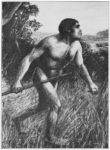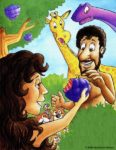By Creation Moments Many of us in the United States watched the total eclipse of the Sun in 2017. I was at my place of work in the state of Washington, where the eclipse was 98%. read more …read more Source: Creation Moments
By Creation Moments Some years ago, a major international software company took out some commercials on British television. The theme of the commercials was that their software was now better than it had ever been because it had evolved. The commercials showed images of dinosaurs and so-called primitive animals as they evolved into more modern, up-to-date varieties. read more …read more Source: Creation Moments
By Creation Moments You must have heard the evolutionary idea that dinosaurs were wiped out by an asteroid hitting the Earth about 66 million years ago – probably on Mexico’s Yucatan Peninsula. Recently, this idea has come under criticism from evolutionists as well as from creationists. Other models for the extinction of the dinosaurs have been explored. read more …read more Source: Creation Moments
By Sarah Chaffee On this episode of ID The Future, computer engineer Robert Marks, co-author of Introduction to Evolutionary Informatics, considers the apocalyptic danger portrayed in The Terminator movies and discussed in all seriousness by some prominent scientists and technologists—the threat of artificial intelligence one day taking over the world. Yes, computing power doubles every couple of years or so, but Dr. Marks insists that a qualitative gulf separates humans from computers, a difference that no amount of computing power can ever overcome. Listen in to learn what it is. Your browser does not support playing Audio, please upgrade your [More]
By Sarah Chaffee On this episode of ID the Future, Steve Laufmann is on the show to discuss an article he published at Evolution News, in which he examines the heart of the debate of whether intelligent design is science. Laufmann discusses the application of demarcation criteria, as well as the role of worldview and bias. Mr. Laufmann is a consultant in the growing field of Enterprise Architecture, dealing with the design of very large, very complex, composite information systems that are orchestrated to perform specified tasks in demanding environments. Your browser does not support playing Audio, please upgrade your [More]
By Creation Moments There is a time and a place to defend your faith. Scripture tells us that we are always to be ready to give that defense to someone who asks us the reason for the hope that is in us (1 Peter 3:15). But what if the questioner is not interested in asking about the hope? read more …read more Source: Creation Moments
By Creation Moments Not every animal appears to be of equal value to God. Some of them, in Genesis 1, were blessed. Then there is the way that God described some of these creatures. read more …read more Source: Creation Moments
By Creation Moments It must have been a very exciting meeting of the Geological Society of London in December 1912. Charles Dawson was presenting a paper concerning a skull that he said had been found at a gravel pit in Sussex, England. The skull appeared to be half human half ape. The prevailing opinion of the time, as it is today, was that apes and humans had a common ancestor from which they had all evolved. read more …read more Source: Creation Moments
By Creation Moments When you come up against a Christian who believes in evolution, your conversations with him will be qualitatively different from the conversations that you might have with an unbeliever. It can be very frustrating and even depressing to encounter a Christian who says that he believes the Bible but does not believe the literal truth of what the Bible teaches in Genesis 1. read more …read more Source: Creation Moments
By Creation Moments It is impossible for us, 6,000 years later, to get into the mind of the first man. For a start, he was created perfect, and we have no idea what it is like to be perfect or to have a perfect mind. Then again, given that he was perfect, we have difficulty in understanding why he would deliberately choose to disobey God and eat the fruit. read more …read more Source: Creation Moments
Many claim that science proves the Earth is billions of years old. But Genesis chapter one teaches that God created the universe and everything in it in only six days. How long ago did God create the universe and how long did He take to do it? Does this issue really matter? Listen: The Timescale of Creation | The Institute for Creation Research
By Sarah Chaffee On this episode of ID The Future, we begin a series on human origins with biologist Ann Gauger, CSC Director of Science Communications. Gauger centers her discussion around a big new anthology from Crossway Books that she contributed to and helped edit, Theistic Evolution: A Scientific, Philosophical, and Theological Critique. Among the tenets of theistic evolution is the idea that humans evolved from a large population of ape-like creatures. But is that idea scientifically plausible? Today’s episode delves into the fossil evidence. Listen in as Gauger describes not a mere gap in the fossil record but a [More]
By Sarah Chaffee On this episode of ID The Future, Ray Bohlin talks with CSC Senior Fellow Jonathan Wells, author of the Zombie Science, about some new hype over Darwin’s finches, an icon of evolution that just won’t die.Seventeen years after Icons of Evolution, Darwin’s finches are back in the news and can still be found in biology textbooks despite the fact that they illustrate no net evolutionary change nor did they play a role in helping Darwin formulate his theory. Your browser does not support playing Audio, please upgrade your browser or find our podcast on podOmatic Download Episode [More]
By Sarah Chaffee On this episode of ID the Future, Sarah Chaffee interviews Ann Gauger about intelligent design laboratory research. Dr. Gauger explains several key projects, including Behe’s review of peer-reviewed work on bacteria and viruses, Biologic’s work with proteins and enzymes, and how these impact the evolution debate. Your browser does not support playing Audio, please upgrade your browser or find our podcast on podOmatic Download Episode …read more Source: id the future
By Creation Moments We know that Noah did not have to fit two of every species of animal on the Ark. The Ark sheltered two of every kind of land and flying vertebrate, not two of every species. For example, modern species like lions and tigers would have developed from the pair from the cat family that were on the Ark. Over time, different species of cats have developed from this pair. read more …read more Source: Creation Moments
By Creation Moments As a child, I was told that frankincense had been brought to Europe by the Frankish people – ancestors of the modern French. This turned out not to be the case. Instead, the prefix frank refers to this incense being of particular high quality or purity. read more …read more Source: Creation Moments
By Creation Moments Carbon dioxide is a wonderful gas. It occurs in the atmosphere at an average concentration of 404 parts per million by volume (ppm). Plants need carbon dioxide to grow. This is the principle source from which plants derive the carbon compounds that they require. Green plants use chlorophyll to catalyze a reaction between carbon dioxide and water vapor that produces sugars and also some free oxygen. read more …read more Source: Creation Moments
By Creation Moments James Ussher is famous, or infamous, depending on your point of view, for his work on creation. It was Ussher who calculated that the Earth was created at 6 pm on the evening before October 23rd 4004 BC. Because of his exactness in choosing this date, he has been criticized and held up for ridicule in recent years. read more …read more Source: Creation Moments
By Creation Moments The years between 1639 and 1651 were times of great turbulence in the British Isles as a series of deadly conflicts were played out. James Ussher was right in the middle of these events, being born, as he was, in Dublin in 1581. In a previous Creation Moment, we related Ussher’s precocious childhood, that led to his famous calculation of the date of creation as 4004 BC. read more …read more Source: Creation Moments
By Sarah Chaffee On this episode of ID The Future, John West, Associate Director of the Center for Science & Culture and author of Walt Disney and Live Action: The Disney Studio’s Live-Action Features of the 1950s and 60s talks about how science is portrayed in Walt Disney’s films and theme parks.Disney’s worldview was an interesting blend of 19th century morals with a 21st century vision for science and technology. A futurist, Disney was given to techno-utopianism and his works tended to reflect this, but have also bore warning messages about the dangers posed by both science and technology. John [More]
By Sarah Chaffee On this episode of ID The Future, Robert Crowther explores the dangers and potential of artificial intelligence with Dr. Robert Marks, Distinguished Professor of Electrical and Computer Engineering at Baylor University and co-author of Introduction to Evolutionary Informatics. Marks uses John Searle’s “Chinese Room” analogy to explain why computers do not have understanding and never will. At the same time, Marks predicts that continuing advances in technology will further augment our abilities. Your browser does not support playing Audio, please upgrade your browser or find our podcast on podOmatic Download Episode …read more Source: id the future [More]
By Creation Moments One lady who approached me after one of my presentations said, “God made the Earth 10,000 years ago, but he made it look like it was millions of years old.” read more …read more Source: Creation Moments
By Creation Moments The atheist physicist Lawrence Krauss believes he has life figured out. As a cosmologist, he adheres to the Big Bang view of origins, believing that the universe came into existence from a singularity about 13.7 billion years ago. read more …read more Source: Creation Moments
By Creation Moments Coldwater Lake in Washington State looks so pretty, nestled between the mountains. This scene of tranquility is very popular among the fishing community. read more …read more Source: Creation Moments
By Creation Moments Gold must be one of the most remarkable elements in the Periodic Table. Its chemical symbol is Au, its atomic number is 79, and its atomic mass is 196.967. It is a lustrous, yellow-colored metal, and is almost chemically inert. It is this lack of chemistry, coupled with its rarity, that gives it its value. read more …read more Source: Creation Moments
By Creation Moments Suppose your friend has a bag of M&Ms. She is counting each color separately. You have five orange M&Ms, and you add them to her mix. But this stops her being able to count them properly. She wants you to remove your five orange M&Ms from the six orange M&Ms that she has. But they are now mixed. How do you know which were the original M&Ms and which were the ones you added? read more …read more Source: Creation Moments
By Creation Moments If you visit London, England, there are a lot of interesting sights to see. You will probably want to take photos of the Horse-guard’s Parade, Westminster Abbey, the Houses of Parliament, and, of course, Buckingham Palace, among many, many other sights. But it might not occur to you to visit the Crystal Palace Dinosaurs. read more …read more Source: Creation Moments






























